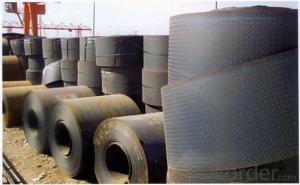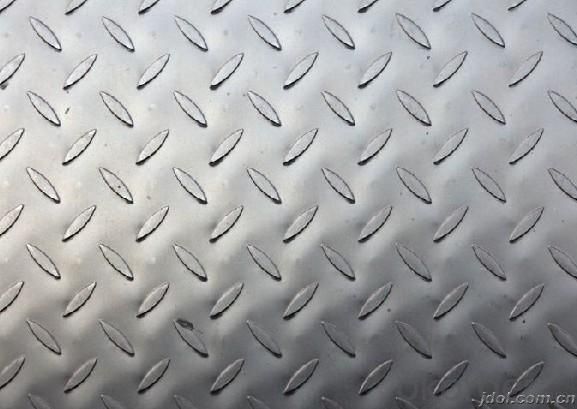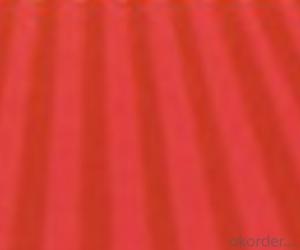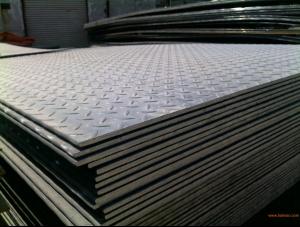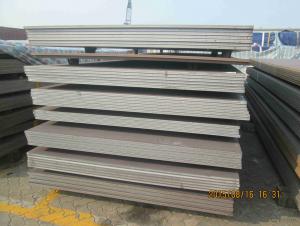High grade hot rolling steel checkered plate
- Loading Port:
- Qingdao
- Payment Terms:
- TT OR LC
- Min Order Qty:
- 500 m.t.
- Supply Capability:
- 50000 m.t./month
OKorder Service Pledge
OKorder Financial Service
You Might Also Like
The pattern shape
A tread surface plate is called a pattern plate, English Name: Diamond plate. The pattern of lentil shaped, diamond, round bean
Shape oblate shape, mixed, the market to the most common lentil shaped.
The specific application of
Pattern plate appearance, can slip, enhanced performance, and many other advantages,such as saving steel in transportation, construction, decoration, equipment around the floor,machinery, shipbuilding and other fields has been widely applied. In general, the use of side of the mechanics pattern plate performance, mechanical performance requirements is not high, so the pattern plate quality mainly flowering rate, as the pattern of pattern height, height difference. At present the common thickness on the market ranging from 2.0-8mm, the width of common 12501500mm two.
The relevant standards
In accordance with the provisions of national standards GB/T 3277 pattern plate, patternheight should be greater than or equal to the thickness of the 20% substrate.
Theoretical calculation of weight
Pattern plate, according to the material (aluminum alloy, stainless steel, ordinary steel etc.)different patterns of different shapes and different weight per square meter adjustment.
Class B common carbon steel rolling, the provisions of chemical composition meet the GB700"ordinary carbon structural steel technical conditions".
Pattern plate of high no less than 0.2 times the thickness of the substrate;
Checkered steel plate according to the weight of the actual weight of delivery or theory;
Mark example: made of Q235-A, size 4*1000*4000mm.
Peaberry pattern plate, mark it as: round bean plate Q235-A-4*1000*4000-GB/T 3277-91
Diamond pattern plate, mark it as: diamond pattern plate B 3-4*1000*4000-GB 3277-82
Steel with hot-rolled state of delivery;
Checkered steel plate surface without bubble, scar, crack, folding and inclusion, plate without delamination.
The surface quality is divided into two levels:
The general accuracy: steel surface with a thin layer of oxide scale and rust allowed, due to other local defects on the surface of oxide scale formed off rough and height or depthexceeds the allowable deviation of the ancient.
Burr height is not obvious and not more than the individual trace lines high allows patterns.The largest area of a single defect pattern with the square of the length of not more than.
High precision: steel surface with a thin layer of oxide scale, allowing the rust and the height or depth of no more than other local defects of half the thickness tolerance.
Pattern intact, a height of not more than half of the tolerance of thickness of the local slightburr allowed patterns.
- Q: What are the different embossing options available for steel sheets?
- There are several embossing options available for steel sheets, including blind embossing, deep embossing, pattern embossing, and textured embossing.
- Q: What are the specifications for steel sheets used in construction?
- The specifications for steel sheets used in construction can vary depending on the specific project requirements. However, common specifications generally include the steel grade (such as ASTM A36 or ASTM A572), the thickness (measured in gauge or millimeters), the width and length dimensions, the surface finish (such as hot rolled or cold rolled), and any additional properties like corrosion resistance or fire resistance. These specifications ensure that the steel sheets meet the necessary strength, durability, and safety standards for their intended use in construction applications.
- Q: Can steel sheets be used for garage doors?
- Yes, steel sheets can be used for garage doors. Steel is a durable and strong material that provides security and protection for garage doors. It is commonly used due to its resistance to weather elements and its ability to withstand impact. Steel sheets are also available in various thicknesses and designs, offering flexibility in aesthetics and functionality for garage doors.
- Q: Are steel sheets easy to install?
- Yes, steel sheets are relatively easy to install due to their lightweight and flexible nature. They can be easily cut and shaped to fit various surfaces, making the installation process more convenient and efficient. Additionally, steel sheets often come with pre-drilled holes, which further simplifies their installation.
- Q: Can steel sheets be used for making furniture?
- Yes, steel sheets can be used for making furniture. Steel is a versatile material that offers several advantages when used for furniture construction. It is known for its strength, durability, and ability to withstand heavy loads. Steel sheets can be shaped, welded, and fabricated into various furniture pieces such as tables, chairs, cabinets, and even bed frames. Additionally, steel furniture tends to be resistant to rust and corrosion, making it suitable for both indoor and outdoor use. The sleek and modern aesthetic of steel also adds a contemporary touch to any space.
- Q: How do steel sheets handle thermal expansion?
- Thermal expansion is managed by steel sheets through their ability to expand and contract in response to temperature fluctuations. When steel is heated, it expands, and when it is cooled, it contracts, just like any other material. However, steel has a relatively low coefficient of thermal expansion compared to other materials, meaning it expands and contracts less for a given change in temperature. This characteristic makes steel sheets more resistant to warping or buckling caused by thermal expansion. Moreover, steel is a robust and long-lasting material, enabling it to withstand the stresses resulting from thermal expansion without significant damage. To further address the effects of thermal expansion, engineers often incorporate expansion joints into structures or employ techniques such as pre-stressing and anchoring to accommodate the expansion and prevent harm. As a result of these properties and design considerations, steel sheets are able to effectively manage thermal expansion.
- Q: Can steel sheets be used in the telecommunications industry?
- Yes, steel sheets can be used in the telecommunications industry. Steel sheets are often used for constructing telecommunication towers and mast structures due to their strength, durability, and ability to withstand harsh weather conditions.
- Q: Can steel sheets be used for soundproofing or insulation?
- Yes, steel sheets can be used for soundproofing or insulation, but they are not as effective as other materials specifically designed for these purposes. Steel sheets can help reduce noise transmission to some extent but might require additional layers or insulation materials for better soundproofing or insulation results.
- Q: Can steel sheets be used in the construction industry?
- Yes, steel sheets can be used in the construction industry. They are commonly used for various applications such as roofing, siding, flooring, and structural components due to their strength, durability, and resistance to fire and corrosion.
- Q: What is the difference between hot-rolled and cold-rolled steel sheets?
- The main difference between hot-rolled and cold-rolled steel sheets lies in their production process. Hot-rolled steel sheets are made by heating the steel above its recrystallization temperature and then rolling it into its final shape, resulting in a rougher surface texture. On the other hand, cold-rolled steel sheets are processed at room temperature, which allows for tighter control over the dimensions and a smoother surface finish. Cold-rolled steel sheets also tend to have higher strength and better formability compared to hot-rolled sheets.
Send your message to us
High grade hot rolling steel checkered plate
- Loading Port:
- Qingdao
- Payment Terms:
- TT OR LC
- Min Order Qty:
- 500 m.t.
- Supply Capability:
- 50000 m.t./month
OKorder Service Pledge
OKorder Financial Service
Similar products
Hot products
Hot Searches
Related keywords
